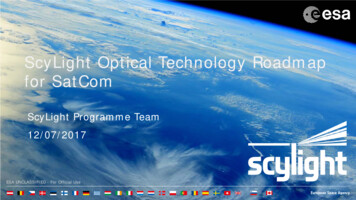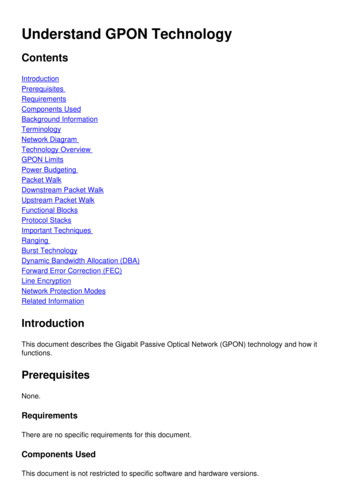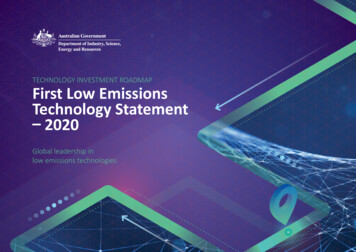
Transcription
ScyLight Optical Technology Roadmapfor SatComScyLight Programme Team12/07/2017ESA UNCLASSIFIED - For Official Use
DRAFT ScyLight Optical TechnologyRoadmap for SatComScyLight Programme Team & European/Canadian Industry12/07/2017ESA UNCLASSIFIED - For Official Use
Workshop on ScyLight Optical Technology Roadmap forSatComAgenda - AMPresentations9.45 ESA Dr. Hauschildt – ‘ARTES ScyLight Roadmap presentation’Coffee-Break10.30 Vialight, Mr Müncheberg – ‘Laser terminals and ground stations for LEOmissions – Status, way forward and feedback to ScyLight Workplan’10.50 DLR, Mr Fuchs – ‘Optical satellite downlinks at DLR’11.10 Tesat, Dr Zech - ‘TESATs LaserCom Product Line11.30 – 13:15 Lunch Break (& ESA Lunch Lecture in same room)ESA UNCLASSIFIED - For Official UseESA 12/07/2017 Slide 3
Agenda - PMPresentations13.30 Fraunhofer IOF – Dr Beckert - ‘The Engineering Model of a high efficient entangledPhoton Source for QKD’13.50 Thales Alenia Space FR – Mr Le Kernec - ‘Thales Alenia Space Optical Communication’14.10 mBryonics Ltd - Dr Mackey - ‘Technology development for end-to-end Lasercomsystems in the 5G era’14.30 Gooch & Housego – Dr Kehayas14.50 Thales Alenia Space CH - Ms Rugi Grond - ‘Thales Alenia Space Optical CommunicationProducts’15.10 ALTYN Mr Achache15.30 AIRBUS Mr Haag15.30-15.45 Coffee-Break15:45 Bi-Laterals in room BF304, as per individual schedules (15min each)ESA UNCLASSIFIED - For Official UseESA 12/07/2017 Slide 4
Optical TelecommunicationsOptical telecommunication is the use of light (opticalfrequency domain) to transmit information: Wavelengths 0.85 μm to 10 μm (30-353 THz) Alternative to the increasing scarce RF spectrum. Optical communication offers an unregulated, extremelybroad spectrumESA UNCLASSIFIED - For Official UseESA 12/07/2017 Slide 5
World of Optical TelecommunicationsOptical linkNOT TO SCALEESA UNCLASSIFIED - For Official UseESA 12/07/2017 Slide 6
World Market Demand and Opportunities Fixed broadband (e.g. HTS - High throughput satellite) and mobile market (e.g.aeronautical, maritime and land) are pushing the satcom capacity demand. This capacity needs to be used where needed: Traffic Flexibility in terms ofbandwidth allocation and coverage Secure communication and service immuneto interferences and jammers Lower frequencies under threat for satcomapplications. Conventional RF frequency spectrumbecomes a scarce resource.Optics is a natural step to unleash resources(bandwidth, high capacity) and fulfil thisgrowing demand.ESA UNCLASSIFIED - For Official UseESA 12/07/2017 Slide 7
Demand and Opportunities Expressed byEuropean Satellite Operators All major European Satellite Operators have expressed interest in Proof-ofConcept Optical Technology as a stepping stone into its adoption in theiroperational satellite fleet. Interest expressed in using optical communications for GEO-ground, GEO-GEO,GEO-LEO, MEO-MEO, and LEO/MEO-ground. Different motivational factors: Freeing RF spectrum for user links (optical feeder links). Data security to deliver to certain users (optical downlink). Communication between space assets (inter-satellite links).ESA UNCLASSIFIED - For Official UseESA 12/07/2017 Slide 8
Where Optical Technologies Can Make aDifference: Opportunities and ChallengesOptical Link High data rate ( 100 Gbps) with smalltelescopes Less mature technology requires R&Deffort Abundant unregulated bandwidth andeffective use of frequency resources Higher precision laser pointing (butdemonstrated) Immunity to interception, jamming,interferers and piracy Lack of common communicationstandards Terrestrial optic technology enable spacemarket (investment already made)For links through the atmosphere: Reduced size/power of ground terminals Potential to reduce the number ofgateways for HTS architecturesESA UNCLASSIFIED - For Official Use Cloud blockage requires a network ofconnected ground stations at suitablelocations Atmospheric conditions (scintillation,beam wander, phase coherence ) Eye safety requirementsESA 12/07/2017 Slide 9
Where Optical Technologies Can Make aDifference: Opportunities and ChallengesOptical Payload Low volume and high speed opticalharness Immature or non-existing technology(e.g. narrow band filters) Signal multiplexing withoutintermodulation No flight heritage Immunity to interference High speed on-board signal processingrequired Generic and frequency independentequipment Enables all-optical end-to-end systems“fibre in the sky” Additional RF/optics conversions needed Marginal benefit for low and mediumcomplex payloads Some building blocks are available fromthe terrestrial marketESA UNCLASSIFIED - For Official UseESA 12/07/2017 Slide 10
Achievements and Trends of Terrestrial OpticalTelecommunicationsSpace opticalcommunicationtechnology as oftodayRichardson D.J., Fini J.M., Nelson L.E. (2013) Space-division multiplexing in optical fibres.Nature Photonics 7, 354-362ESA UNCLASSIFIED - For Official UseESA 12/07/2017 Slide 11
ARTES ScyLight – a quick reminderThe objectives of ScyLight are: Address the development and use of innovative optical technologies for SatCom as well asnew market opportunities. Demonstrate the maturity of optical communication technology to the end user community. Support industry to develop capabilities and competitiveness in the field of opticaltechnologies, enabling related emerging market opportunities for products based on the newlydeveloped technologies.ScyLight will address the following thematic areas:ooooESA UNCLASSIFIED - For Official UseCommon System &Technologies ActivitiesOptical Communication Terminals and componentsIntra-Satellite Photonics /Optical PayloadsQuantum Cryptography TechnologiesESA 12/07/2017 Slide 12
ScyLight – Thematic LinesESA UNCLASSIFIED - For Official UseESA 12/07/2017 Slide 13
Unleash full capacity of Optical CommunicationTechnology and ensure competitivenessESA UNCLASSIFIED - For Official UseESA 12/07/2017 Slide 14
History of System and Optical developments forSpaceIn December 2016, in Lucerne(Switzerland), ESA Member States adopteda ‘Resolution on their Vision of a UnitedSpace in Europe in the era of Space 4.0’ESA UNCLASSIFIED - For Official UseESA 12/07/2017 Slide 15
Applications and Impact of Optical SatcomInter-Satellite Optical Links High-capacity data relay links Inter-satellite constellation links Backbone connectivity Government, commercial, scientific users Global Real-time data access via (E)DRS/GlobeNetHigh throughput and high volume data dumpingSecurity, interference immunityFlexible connectivity, direct transmissionBi-Directional links, forward taskingChallenges Industrialisation of telescope assembly, frame unit structure, coarse pointing assembly, laserterminal reliabilitye.g. Sentinel - EDRS Temperature, volume, mass and cost constraints(2015), GlobeNet (2021)Technology roadmap20162017EDRS-A SentinelsESA UNCLASSIFIED - For Official Use2018EDRS-C201920202021GlobeNet S1-C S2-CESA 12/07/2017 Slide 16
Applications and Impact of Optical SatcomSatellite to Ground Optical Links Direct data downlink from LEO Government and scientific users, mobile terminals High rate data dumping to ground Immunity to interference and jammers Size/power compatible with small satellitesChallenges Volume reductionsRadiation hardnessThermal environmentIncrease the current data ratesCost of new optical ground station networkOperational constraintsTechnology roadmap20142015T-AOGSESA UNCLASSIFIED - For Official Use2016On-board demonstratoron ISS201720182019TeslaOptel-u2020OGS adaptopticsESA 12/07/2017 Slide 17
Applications and Impact of Optical SatcomGround-Satellite Optical Links High capacity gateway links GEO-ground optical links Commercial users for high throughput multi-beam systems (e.g. terabit) Virtually unlimited capacity with one single gatewayFewer ground stationsImmunity to interference and jammers, securityIncreases available RF spectrum for user linkChallenges Adaptive optics on uplink and downlink On-board high speed data processing Ground stations at reliable (weather, political) locations Cost of new optical ground station network Hand-Over Concepts/ConOpsTechnology roadmapESA UNCLASSIFIED - For Official Use2017201820192020 .Proof of conceptfeeder linkfeasibility demo.Gateway link (2025)2025feeder link demoESA 12/07/2017 Slide 18
Applications and Impact of Optical SatcomAirborne Optical Links Communication with aircraft, UAV, high altitude platforms (HAPs) Government and commercial users High capacityLink unaffected by clouds for HALEsSecuritySmall terminalsFrench experiment LOLA link demonstrated to ARTEMIS (2006)Challenges High precision laser beam steering Vibration and attitude stability Optical terminals meeting aircraft technology certificationand standards to be developed Long lasting/Continuous links require dedicated terminalsonboard the satelliteTechnology roadmapESA UNCLASSIFIED - For Official Use20142015201620172018On-board technologydemonstrator (2021)2019Demonstratorvia EDRS20202021GlobeNetESA 12/07/2017 Slide 19
Intra-Satellite Photonics/Optical Payload Transmit Section Optical-to-ElectricalConversion Optical Beamforming Optical Upconversion Optical Switching Optical Digital-toAnalogue Conversion Digital Signal Processor(using optical HSSL2) Optical Analogue-toDigital Conversion Optical Downconversion Optical Beamforming Electrical-to-OpticalConversion Receive SectionConceptual Block Diagram1 Optical Multi-LO Generation and DistributionRFDomainOpticalDomainESA UNCLASSIFIED - For Official UseDigitalDomain1.2.S. Pan et al. “Satellite Payloads Pay Off”, IEEE Microwave Magazine, September 2015.HSSL high speed serial links.ESA 12/07/2017 Slide 20
Intra-Satellite Photonics/Optical Payload Transmit Section Optical Beamforming Optical Upconversion Optical Switching Optical Digital-toAnalogue Conversion Digital Signal Processor(using optical HSSL2) Optical Analogue-toDigital Conversion Optical Downconversion Optical Beamforming Receive SectionAll optical Conceptual Block Diagram Optical Multi-LO Generation and DistributionRFDomainOpticalDomainESA UNCLASSIFIED - For Official UseDigitalDomain2. HSSL high speed serial links.ESA 12/07/2017 Slide 21
Applications and Impact of Optical SatcomIntra-Satellite Photonics/Optical Payload Communications Satellite operators High capacitySimplificationMass and power reductionLower losses, increased efficiencyChallenges Vibration and environmental stability, lifetimeTranslation of ground to flight technologies – miniaturizationSystem design digital, RF and opticalA complete payload – not just equipment (to unleash full capabilities)On-board technologyNarrow band filteringTechnology roadmapESA UNCLASSIFIED - For Official Usedemonstrator (2021)See following slideESA 12/07/2017 Slide 22
Intra-Satellite Photonics/Optical PayloadTechnology Roadmap201720182019202020212022Optical FrequencyConversionPhotonic frequencyconversion unitOptical A/D & D/AConversionOpticalinterconnects .Photonic RFfilteringASICs withembeddedoptical I/OsPhotonic routingunitOptical SwitchingESA UNCLASSIFIED - For Official Use2025Frequencydownconversionunit & samplerOptical High Speed SerialLinks(All)Optical Demo2024PhotonicbeamformingunitOptical BeamformingOptical Multi-LOGeneration & Distribution2023Photonicdistributionof RF LOsPhotonicfrequencygeneration unit(all) opticaldemo missionESA 12/07/2017 Slide 23
Photonic Integrated Circuits - MicrophotonicsESA is in the forefront of introducing micro-photonics in its COMSAT PLs.Currently microphotonic technologies are considered for most equipment involvedin Microwave Photonics Payloads: Photonic Frequency Generation Unit Photonic Frequency Conversion Unit Photonics Routing Unit Photonic RF Filtering Photonic Beam FormingESA UNCLASSIFIED - For Official UseESA 12/07/2017 Slide 24
Applications and Impact of Optical SatcomSystem activities System Studies Government and commercial users MarketingTechnologySafetyAtmospheric modeling and long term monitoringComplete end-to-end system usesChallenges Site diversity/modelingSpace Standards on optical are missing – including safetyIdentifying new market opportunities or expanding existing marketsTechnology gap or productsTechnology roadmapESA UNCLASSIFIED - For Official Use20172018End2End Atmospheric Safe laserSystem modeling & usemonitoring2019ESA 12/07/2017 Slide 25
Status of Optical Technologies for Telecom PayloadsQuantum Key Distribution (QKD): Defense, Government, Financial, Telecom, Utility services Counter Quantum computing power - hackingFewer ground stations – removed security riskImmunity to interference and jammers - detectableInternational need for secure key distribution Space Qualified Quantum receivers/transmitters QKD Protocol On-board and on-ground data processing Ground station locations/Atmospheric influence Optical Terminals compatible to link budget Stringent requirements and size/mass/power constraints Concept of OperationsTechnology roadmap20152016201720182019ChallengesESA UNCLASSIFIED - For Official UseAlphasat QKDtestsChinese QKDsatellite2021 .QKD demofrom ISS2023CommercialQKD missionESA 12/07/2017 Slide 26
Applications and Impact of Optical Satcom:International SummaryDevelopment and deployment of optical technology on-board satellitesApplications roadmapInter-satellite optical Optel-uDirect downlink from LEOGateway and GEO-groundlinksOGS adapt opticsLCRDAirborne optical linksEDRS demonstratorIntra-satellite opticalpayload – please see detailed slideLO distributionOPALS: Optical Payload for Lasercomm Science (NASA)OSIRIS: Optical Space Infrared Downlink System (DLR)ISS: International Space StationSOTA: Small Optical Transponder (NICT)LCRD: Laser Communications Relay Demonstration (NASA)EDRS: European Data Relay System (ESA)ESA UNCLASSIFIED - For Official Use2021Gateway linkGlobenetMultiple Photonic equipmentESANon-ESAESA 12/07/2017 Slide 27
Optical CommunicationsChallenges to be tackle?SystemLaser terminalsAdaptive OpticsPre-distortion technoGround stationsFilteringCoarse pointingmechanismsTelescopeAssembliesESA UNCLASSIFIED - For Official UseAtmospheric modellingSystem definitionStandards: Safety Signals Modulation Coding AcquisitionstrategySize and powercompatibilityMarketidentification andpenetrationFlight qualificationReliabilityWall-plug efficiencyof lasers andamplifiersESA 12/07/2017 Slide 28
Conclusions (1/2) Optical communication is still a brand new solution with unique, not yet unleashed potential The DRAFT roadmap has identified potential applications and the main challenges. Excellentresults have already been achieved. Europe is currently in the lead for optical inter-satellite communications, however: Non-ESA countries, USA & Japan in particular, are moving quickly, targeting full opticalsystems within 10 years. ESA is implementing and running activities to increase the TRL level for keytechnologies/products in ScyLight, ARTES C&G/AT and TRP. ESA needs to undertake a substantial system study to analyse technical requirements,assess the feasibility ESA needs to proof the maturity of the technology and define solid solutions Optical technologies cover the entire value chain: an opportunity for small and medium-sizeenterprises. .ESA UNCLASSIFIED - For Official UseESA 12/07/2017 Slide 29
Conclusions (2/2) Via ScyLight and ARTES, ESA is continuously supporting optical technologies to bring theoptical technology to commercial success. BUT . What is missing? Where are uncovered gaps? What are the challenges identified by Industrial Players? If not today in your presentations and bi-laterals, please provide any comments oradditions that you wish to share:ScyLight@esa.intESA UNCLASSIFIED - For Official UseESA 12/07/2017 Slide 30
ARTES ScyLight work plan activities - currentActivity Ref.SL.001TitleOptical technologies for next generation communication 1/18System and sub-system performance requirements for the next generation VHTSand a development roadmap for the critical enabling technologies.SL.002Optical technologies for next generation optical inter-satellite linksSystem and sub-system performance requirements for the next generation ofoptical inter-satellite links and a development roadmap for the critical enablingtechnologies.SL.003Optical communication requirements for scientific missions and the Moon villageSystem and sub-system performance requirements for scientific missions or ingeneral long distance communications and a development roadmap for the criticalenabling technologies.SL.004Guidelines for the safe use of laser technologyIn this activity the various risks associated with the use of laser technology in theimplementation and operation of a satellite communication system shall beidentified and categorised. Handling and operational constraints and protectionmeasures shall be established for each of the identified risk scenarios andconsolidated in a set of safety guidelines for industry and operators.ESA UNCLASSIFIED - For Official UsePriority P2 ESA ITT onlyissued onrequest byDelegationsESA 12/07/2017 Slide 31
ARTES ScyLight work plan activities - currentTitlePriorityPlannedforAtmospheric monitoring to assess the availability of optical links through theatmosphereImproved knowledge of the optical link availability for selected optical groundstation locations and validation of long term optical link availability predictionmethods.Uninterrupted handover for optical earth-space links using site diversityP1Q4/17P1Q1/18P1Q2/18P2n/aActivity Ref.SL.005SL.006Validated site diversity concepts for optical earth-space links.SL.007Assessment of analogue optical links through the atmosphereDemonstration of reliable analogue optical links through the atmosphere.SL.008Space assessment of optical amplitude modulatorsUnderstanding of the environmental effects (e.g., temperature, radiation, charging)impacting the bias point behaviour of optical amplitude modulators.Verification of countermeasures to minimise drift of the bias point of amplitudeoptical modulators.ESA UNCLASSIFIED - For Official UsePriority P2 ESA ITT onlyissued onrequest byDelegationsESA 12/07/2017 Slide 32
ARTES ScyLight work plan activities - currentActivity Ref.SL.009TitlePhotonics phased array for optical feeder der link technology based on photonics phase shifters, without deformablemirrors.SL.010SL.011Use of secure optical communication technologies to protect European criticalinfrastructureTechnical and operational requirements for the protection of critical infrastructure byspace-based systems and a development roadmap for the critical enablingtechnologies.Quantum key distribution protocols for space applicationsSL.012Model for quantum key distribution protocol performance prediction and adevelopment roadmap for the critical enabling technologiesSpace qualified faint pulse laser source for quantum key distributionIncrease the technical readiness level of faint pulse laser sources suitable forquantum key distribution applications from 5 to 7.ESA UNCLASSIFIED - For Official UsePriority P2 ESA ITT onlyissued onrequest byDelegationsESA 12/07/2017 Slide 33
ARTES AT activities – 2018 work planActivity Ref.TitlePriority5C.353Compact high power laser source for low earth orbit to ground useP15C.364The objective of the activity is to develop a high power compact directlymodulated laser source for data transmission between LEO satellites and groundwith an average output power greater than 1W and with a beam quality factorof less than 1.3.Large scale integrated photonic switch matrixP13B.035The objective of the activity is to develop a packaged, photonic integratedswitch matrix as needed for on board photonic front ends with at least fiftyindividual input and outputs.Optical feeder-uplink pre-compensation based on double-starsP2PlannedforThe objective of this activity is to carry out a measurement campaign anddevelop waveform pre-compensation model based on information coming fromdouble-stars.Priority P2 ESA ITT onlyissued on request byDelegationsESA UNCLASSIFIED - For Official UseESA 12/07/2017 Slide 34
Wrap up – Feedback on the ScyLight RoadmapConfirmation of ScyLight Concept on: Need for Networking between industrial partners also for development of building blocks or subsystems System Level Aspects important Early In Orbit Demonstrations required (e.g. ScyLight Demo Phase) Need for Standardization activities in different bodies Need for coordination ESA/EC BUT: we need to speed up Additional Topics for the Roadmap and the Line 1/ESA Workplan Constellations Technology/LEO-LEO ISLs Mass and Cost Reduction/Series Production Methods Precision Engineering MethodsESA UNCLASSIFIED - For Official UseESA 12/07/2017 Slide 35
Comments?Please provide any comments or additions that you wish to share after todayspresentation:ScyLight@esa.intNote 1: Presentations will be made available via the ScyLight Web pagesNote 2: Pickup for the bi-lateral Meeting will be at the reception/main entranceESA UNCLASSIFIED - For Official UseESA 12/07/2017 Slide 36
Interest expressed in using optical communications for GEO-ground, GEO-GEO, GEO-LEO, MEO-MEO, and LEO/MEO-ground. Different motivational factors: Freeing RF spectrum for user links (optical feeder links). Data security to deliver to certain users (optical downlink). Communication between space assets (inter-satellite links).










